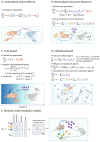Ecological modelling approaches for predicting emergent properties in microbial communities
- PMID: 35577982
- PMCID: PMC7613029
- DOI: 10.1038/s41559-022-01746-7
Ecological modelling approaches for predicting emergent properties in microbial communities
Abstract
Recent studies have brought forward the critical role of emergent properties in shaping microbial communities and the ecosystems of which they are a part. Emergent properties-patterns or functions that cannot be deduced linearly from the properties of the constituent parts-underlie important ecological characteristics such as resilience, niche expansion and spatial self-organization. While it is clear that emergent properties are a consequence of interactions within the community, their non-linear nature makes mathematical modelling imperative for establishing the quantitative link between community structure and function. As the need for conservation and rational modulation of microbial ecosystems is increasingly apparent, so is the consideration of the benefits and limitations of the approaches to model emergent properties. Here we review ecosystem modelling approaches from the viewpoint of emergent properties. We consider the scope, advantages and limitations of Lotka-Volterra, consumer-resource, trait-based, individual-based and genome-scale metabolic models. Future efforts in this research area would benefit from capitalizing on the complementarity between these approaches towards enabling rational modulation of complex microbial ecosystems.
© 2022. Springer Nature Limited.
Conflict of interest statement
The authors declare no competing interests.
Figures



References
-
- Lynch SV, Pedersen O. The Human Intestinal Microbiome in Health and Disease. New England Journal of Medicine. 2016;375(24):2369–2379. - PubMed
Publication types
MeSH terms
Grants and funding
LinkOut - more resources
Full Text Sources
Research Materials

